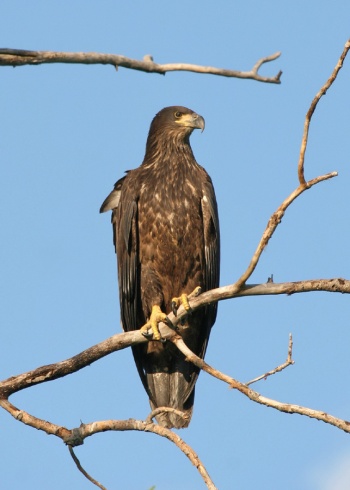(User template added to Photo) |
(Photo of Immature. Attempt made to disguise some copied text. Taxonomy expanded. References) |
||
| Line 1: | Line 1: | ||
| − | [[Image:Bald_Eagle.jpg|thumb|550px|right|Photo by {{user|ixodid|ixodid}}<br/> | + | [[Image:Bald_Eagle.jpg|thumb|550px|right|Photo by {{user|ixodid|ixodid}}<br />Topeka, [[Kansas]], [[USA]]]] |
;[[:Category:Haliaeetus|Haliaeetus]] leucocephalus | ;[[:Category:Haliaeetus|Haliaeetus]] leucocephalus | ||
==Identification== | ==Identification== | ||
| Line 8: | Line 8: | ||
*Heavy yellow bill<br/> | *Heavy yellow bill<br/> | ||
| − | + | '''Immature''' birds lack the white head and tail (resembling adult [[Golden Eagle]]). The have a black bill and a varying amount of white plumage. | |
| − | + | [[Image:IMG 6622 57-1bf.jpg|thumb|350px|right|Immature<br />Photo by {{user|Jim+Crosswell|Jim Crosswell }}<br />Windsor, [[Ontario]], July 2008 ]] | |
| + | ==Distribution== | ||
| + | Breeds from [[Alaska]] east to [[Newfoundland]] and south locally to [[California]], [[Great Lakes]], and [[Virginia]]; also in [[Arizona]], along [[Gulf Coast]], and in [[Florida]]. Formerly more widespread. Winters along coasts and large rivers in much of [[United States]]. | ||
====Endangered Status==== | ====Endangered Status==== | ||
The Bald Eagle is on the U.S. Endangered Species List. | The Bald Eagle is on the U.S. Endangered Species List. | ||
| − | |||
| − | |||
| − | |||
| − | |||
==Taxonomy== | ==Taxonomy== | ||
| − | There are | + | ====Subspecies<sup>[[#References|[1]]]</sup>==== |
| − | * ''H l | + | There are 2 subspecies: |
| − | * ''H l | + | *''H. l. washingtoniensis'': |
| − | * | + | :*Locally in [[Aleutian Islands]], [[Alaska]], [[Canada]] and northern [[US]] |
| + | *''H. l. leucocephalus'': | ||
| + | :*Locally from southern [[US]] to north-western [[Mexico]] | ||
| + | A third subspecies ''alascanus''<sup>[[#References|[2]]]</sup> is not recognised by all authorities. | ||
==Habitat== | ==Habitat== | ||
Lakes, rivers, marshes, and seacoasts. | Lakes, rivers, marshes, and seacoasts. | ||
| − | |||
==Behaviour== | ==Behaviour== | ||
| − | + | ====Breeding==== | |
| − | + | They build a large nest of sticks on top of a cliff or in a tall tree. Two to three white eggs are laid. | |
| − | + | ====Diet==== | |
| − | + | Their main diet is fish, which is snatched from the surface of water. Alternatively they will rob an [[Osprey]] of its catch | |
====Vocalisation==== | ====Vocalisation==== | ||
Squeaky cackling and thin squeals. | Squeaky cackling and thin squeals. | ||
| − | + | ==References== | |
| − | + | #{{Ref-Clements6thDec08}}#Avibase | |
| + | #eNature | ||
| + | {{ref}} | ||
==External Links== | ==External Links== | ||
{{GSearch|Haliaeetus+leucocephalus}} | {{GSearch|Haliaeetus+leucocephalus}} | ||
Revision as of 17:00, 26 July 2009
- Haliaeetus leucocephalus
Identification
L. 30-31" (76-79 cm)
W. 6-7' 6" (1.8-2.3 m)
- Large blackish eagle
- White head and tail
- Heavy yellow bill
Immature birds lack the white head and tail (resembling adult Golden Eagle). The have a black bill and a varying amount of white plumage.
Distribution
Breeds from Alaska east to Newfoundland and south locally to California, Great Lakes, and Virginia; also in Arizona, along Gulf Coast, and in Florida. Formerly more widespread. Winters along coasts and large rivers in much of United States.
Endangered Status
The Bald Eagle is on the U.S. Endangered Species List.
Taxonomy
Subspecies[1]
There are 2 subspecies:
- H. l. washingtoniensis:
- Locally in Aleutian Islands, Alaska, Canada and northern US
- H. l. leucocephalus:
A third subspecies alascanus[2] is not recognised by all authorities.
Habitat
Lakes, rivers, marshes, and seacoasts.
Behaviour
Breeding
They build a large nest of sticks on top of a cliff or in a tall tree. Two to three white eggs are laid.
Diet
Their main diet is fish, which is snatched from the surface of water. Alternatively they will rob an Osprey of its catch
Vocalisation
Squeaky cackling and thin squeals.
References
- Clements, JF. 2008. The Clements Checklist of Birds of the World. 6th ed., with updates to December 2008. Ithaca: Cornell Univ. Press. ISBN 978-0801445019.
- Avibase
- eNature
Recommended Citation
- BirdForum Opus contributors. (2024) Bald Eagle. In: BirdForum, the forum for wild birds and birding. Retrieved 6 June 2024 from https://www.birdforum.net/opus/Bald_Eagle
External Links





